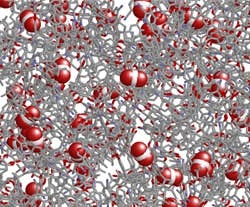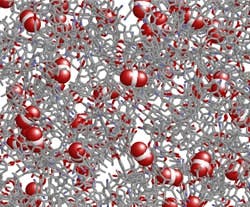Polymer promises better CO2 removal
Material with intrinsic microporosity would be teamed with catalyst. Photo: Flor Siperstein, University of Manchester.
A so-called polymer of intrinsic microporosity (PIM) whose structure resembles crispy noodles incorporated into a composite membrane with a synthetic catalyst may provide more effective removal of carbon dioxide from flue gases. That’s the hope of Peter Budd, a materials chemist at the Organic Materials Innovation Centre of the University of Manchester, Manchester, U.K. He has received a £150,000 (the equivalent of about $300,000) grant from the U.K.’s Engineering and Physical Sciences Research Council to conduct a feasibility study.
“The essential idea we are testing is that it should be possible to greatly increase the selectivity of a membrane for CO2 by incorporating a synthetic material that behaves in a similar way to carbonic anhydrase. Carbonic anhydrases are a family of enzymes that catalyze the reversible hydration of CO2 to bicarbonate,” Budd explains.
“When the polymer is used as a gas separation membrane, it has a very high permeability to CO2, and also a high selectivity for CO2 over, for example, N2 or CH4. However, for a membrane system that will significantly outperform other technologies, a substantial increase in selectivity is required over that achievable with a polymer alone. The feasibility study is to test the idea of incorporating a catalytic component that will encourage selective transport of CO2 from a gas mixture into an aqueous phase, then from that aqueous phase into a stream of pure gas.”
Budd foresees significant advantages for this approach over alternative CO2-removal technologies such as absorption, pressure-swing adsorption and cryogenic separation. “…A membrane process, if a sufficiently selective membrane system can be developed, arguably offers the greatest potential for cost-effective and energy-efficient separation.”
Should the study prove favorable, piloting is several years away, he adds.

